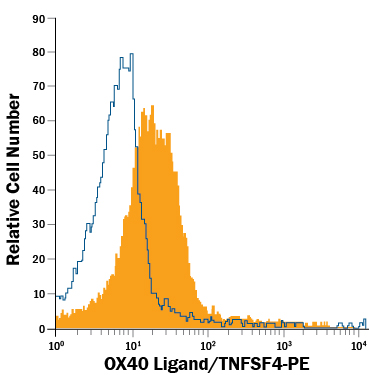Mouse OX40 Ligand/TNFSF4 PE-conjugated Antibody Summary
Gln49-Leu198
Accession # P43488
Applications
Please Note: Optimal dilutions should be determined by each laboratory for each application. General Protocols are available in the Technical Information section on our website.
Scientific Data
 View Larger
View Larger
Detection of OX40 Ligand/TNFSF4 in Activated Mouse Splenocytes by Flow Cytometry. Mouse splenocytes were treated with LPS and recombinant mouse GM-CSF (Catalog # 415-ML), then stained with Goat Anti-Mouse OX40 Ligand/TNFSF4 PE-conjugated Antigen Affinity-purified Polyclonal Antibody (Catalog # FAB1236P, filled histogram) or isotype control antibody (Catalog # IC108P, open histogram). View our protocol for Staining Membrane-associated Proteins.
Reconstitution Calculator
Preparation and Storage
Background: OX40 Ligand/TNFSF4
OX40 Ligand (OX40L), also known as gp34, is a type II transmembrane glycoprotein belonging to the TNF superfamily. Murine OX40L cDNA encodes a 198 amino acid (aa) residue protein comprised of a 28 aa N-terminal cytoplasmic domain, a 20 aa transmembrane segment, and a 150 aa C-terminal extracellular domain (1). Human and murine OX40L share 46% sequence identity at the amino acid level (1). The OX40L is expressed on activated antigen presenting cells such as B cells, macrophages, dendritic cells, and on endothelial cells at the site of inflammation. The receptor for OX40L is OX40 (CD134) that is expressed predominantly on activated CD4+ T cells. Expression of OX40 is transient following engagement of T cell receptors (2). Ligation of OX40L by OX40 stimulates proliferation and differentiation of activated B cells, and increases immunoglobulin secretion (3, 4). The expression of OX40L on B cells is up-regulated by CD40 ligation (3). Engagement of the OX40-OX40L system has co-stimulatory effects on T cells by stimulating the production of cytokines by T helper cells and increasing the survival of memory T cells (2, 5). Blocking of the OX40-OX40L interaction in vitro inhibits co-stimulation resulting in decreased T cell proliferation and adhesion of T cells to endothelial cells. Inhibition of the OX40-OX40L interaction in disease models has beneficial effects in acute graft-versus-host disease, inflammatory bowel disease, and decreases the development of collagen-induced arthritis and experimental leishmaniasis (6).
- Baum, P.R. et al. (1994) EMBO J. 13:3992.
- Gramaglia, I. et al. (1999) J. Immunol. 161:6510.
- Stuber, E. et al. (1995) Immunity 2:507.
- Malstrom, V. et al. (2001) J. Immunol. 166:6972.
- Maxwell, J.R. et al. (2000) J. Immunol. 164:107.
- Weinberg, A.D. (2002) Trends Immunol. 23:102.
Product Datasheets
FAQs
No product specific FAQs exist for this product, however you may
View all Antibody FAQsReviews for Mouse OX40 Ligand/TNFSF4 PE-conjugated Antibody
There are currently no reviews for this product. Be the first to review Mouse OX40 Ligand/TNFSF4 PE-conjugated Antibody and earn rewards!
Have you used Mouse OX40 Ligand/TNFSF4 PE-conjugated Antibody?
Submit a review and receive an Amazon gift card.
$25/€18/£15/$25CAN/¥75 Yuan/¥2500 Yen for a review with an image
$10/€7/£6/$10 CAD/¥70 Yuan/¥1110 Yen for a review without an image



